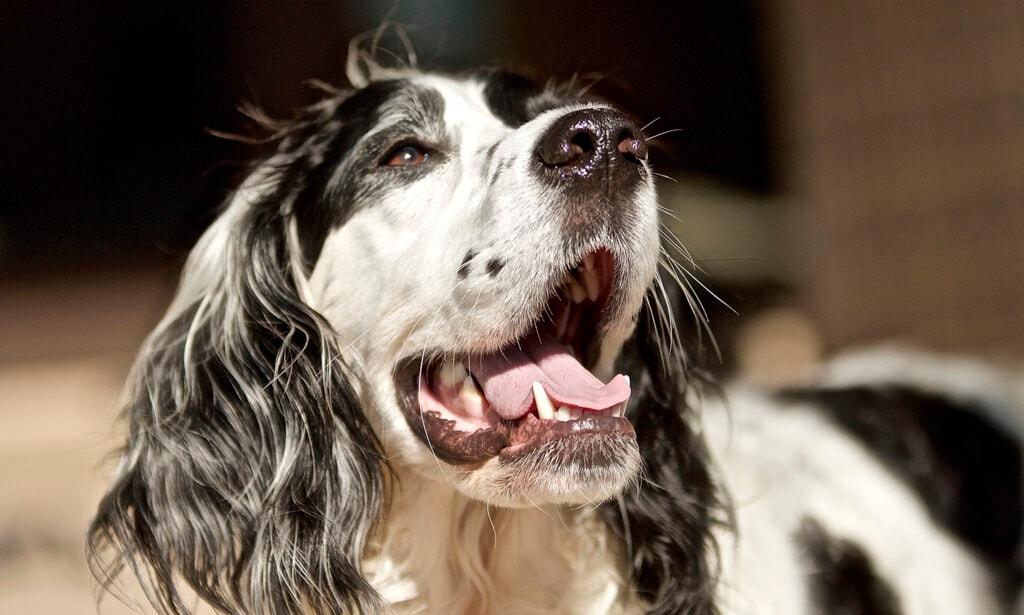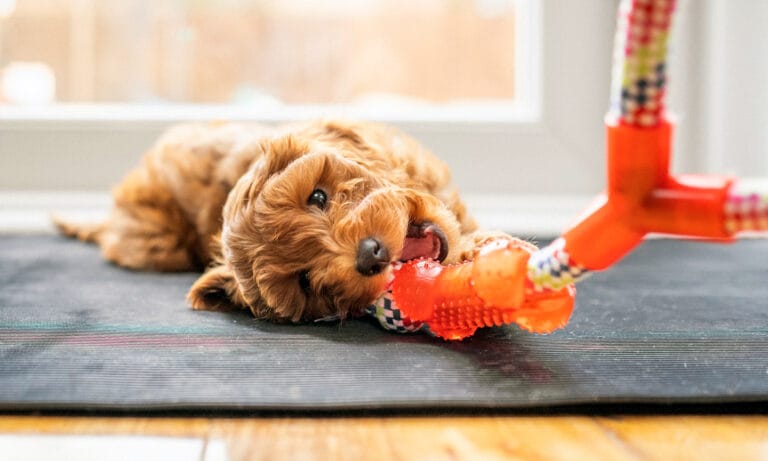Your pup cozies up for some cuddle time, and—whoa—you catch a whiff of seriously stinky dog breath. Many pet parents think bad breath in dogs is normal, but it can be more than just a nose-wrinkler. It might signal an underlying health issue.
Often referred to as halitosis in dogs, this condition is commonly linked to dental disease but can also stem from systemic health problems, or issues with digestion or diet. Figuring out what’s behind the funk is the first step to improving your dog’s health and freshening things up.
In This Guide:
Is Bad Breath in Dogs a Sign of Illness?
Bad breath isn’t always a sign of illness, says Ashly Smith, DVM, regional medical director for Small Door Veterinary.
“Mild or temporary bad breath can result from dietary choices or licking smelly things,” Dr. Smith says. “However, persistent bad breath is often a sign of an underlying issue, such as dental disease or a systemic health condition, so it shouldn’t be ignored.”
What Causes Bad Breath in Dogs?
When your dog’s breath can’t be dismissed as the aftermath of a questionable backyard snack, it might point to a more serious issue.
The most common causes of bad breath in dogs include:
Periodontal Disease
“The most common cause of bad breath in dogs is periodontal disease, which is caused by plaque and tartar building up on their teeth,” explains Ray Spragley, DVM, founder of Zen Dog Veterinary Care, in Tuckahoe, New York. This buildup is full of bacteria, which release stinky sulfur compounds that create an unpleasant odor.
Untreated periodontal disease can also lead to infection and tooth decay, as well as abscessed teeth, all of which can further contribute to the unpleasant smell.
Something Stuck in Their Teeth or Mouth
Dogs who like to chew on bones, toys, ropes, or sticks risk having foreign objects become lodged between their teeth or in their mouths. Left untreated, this—along with cuts and scrapes in their mouth—can result in an infection that causes bad breath.
Ingestion of Something Stinky or Toxic
“Dogs who scavenge or eat inappropriate items (like garbage or feces) may develop temporary bad breath,” Dr. Smith says.
Bad breath can also be a sign that your dog has ingested something toxic, such as certain plants, chemicals, or human foods like onions or garlic.
If you suspect poisoning, immediately contact your vet or the Pet Poison Helpline at (855) 764-7661. A consultation fee applies.
Gastrointestinal Issues
When digestion isn’t working as it should—whether due to food allergies, poor diet, or chronic inflammation—it can lead to an overgrowth of harmful bacteria in the gut.
Referred to as “dysbiosis,” this can cause issues such as acid reflux, poor nutrient absorption, and gases from undigested food traveling up the esophagus, all of which can contribute to bad breath.
Kidney Disease
Bad breath that has an ammonia (urine-like) smell to it is often a red flag for kidney disease in dogs.
When the kidneys aren’t functioning properly, toxins called urea that are normally filtered out of the blood build up, leading to distinct-smelling bad breath, explains Dr. Spragley.
This condition is usually accompanied by other symptoms, such as vomiting, increased thirst, frequent urination, and lethargy.
Liver Disease
A malfunctioning liver struggles to filter toxins from the bloodstream, which can result in stinky breath.
Other warning signs of liver disease can include vomiting, diarrhea, or a yellowish tint to the gums and eyes.
Diabetes
“Diabetes can cause your dog’s breath to have a sweet smell to it,” Dr. Spragley says. “This happens due to the very high glucose levels in their bloodstream.”
Other symptoms of diabetes include increased thirst, weight loss, and frequent urination.
Oral Tumors
Oral tumors, whether benign or malignant, can cause bad breath due to tissue decay and infection in the affected area, says Dr. Smith. These growths might also make it difficult for your dog to eat or chew normally.
How Do Vets Treat Bad Breath in Dogs?
If your dog has persistent bad breath or shows any other unusual symptoms, take them to the vet ASAP.
The vet will perform a thorough examination, which might include:
- Checking the teeth and gums
- Assessing the mouth for injuries or infections
- Conducting blood work or imaging to rule out systemic issues, such as kidney or liver disease
Treatment depends on the diagnosis:
- For dental disease, a professional cleaning or tooth extraction might be required.
- Infections or injuries might be treated with antibiotics or other medications, like pain meds.
- Systemic conditions such as diabetes or kidney disease will need specific treatments to manage the underlying problem.
How To Help Get Rid of Your Dog’s Bad Breath
You can try several oral hygiene strategies to tackle your dog’s bad breath.
If the odor is due to early plaque buildup, these methods might eliminate it entirely. However, Dr. Smith stresses that they won’t resolve bad breath caused by more serious conditions, such as periodontal disease or systemic illness.
That said, the following practices can help reduce the smell while you address the underlying issue with your vet:
- Brush your dog’s teeth daily. Use a dog-safe toothbrush and dog-safe toothpaste. This helps remove odor-causing plaque and reduces the risk of dental disease, Dr. Smith explains.
- Offer dental chews. Dental treats for bad breath in dogs can stimulate saliva production and scrape away plaque and tartar as your dog chews, Dr. Smith says. Some dental chews, such as OraVet Dental Hygiene Chews, also have coatings that prevent bacterial attachment.
- Try water additives or food powders. Water additives, which are added to your dog’s water bowl, often contain enzymes or antimicrobial agents to reduce bacteria and freshen breath, Dr. Smith notes. Dental powders, like ProDen PlaqueOff Powder, are another option; you can add them to your dog’s wet or dry food.
- Use dental wipes or rinses. Keep dental wipes or rinses on hand for quick and easy oral care. They’re particularly good for those times when brushing isn’t an option or in between brushing sessions.
- Provide dental toys. Dental dog toys, like the KONG Dental Dog Toy, can help scrape away plaque as your dog chews. Bonus? They will keep your pup entertained—win-win!
- Consider a dental diet. Dental dog foods—like Hill's Science Diet Adult Oral Care—are specifically formulated to reduce plaque, tartar, and bad breath. These diets often feature specially shaped kibble that helps clean your dog’s teeth as they chew. Speak with your vet before switching your dog’s food, though.
When choosing dental products, Dr. Smith recommends choosing those accepted by the Veterinary Oral Health Council (VOHC). “This ensures the product has been independently tested and proven to be effective at reducing plaque and tartar,” she says.
How Do I Prevent Bad Breath in My Dog?
- Prioritize dental health. Good oral hygiene is the most impactful way to prevent bad breath. Regular brushing and incorporating VOHC-approved products, such as dental chews or water additives, can go a long way toward keeping your dog’s mouth healthy and odor-free.
- Schedule routine vet checkups. Regular checkups help catch dental disease and conditions such as diabetes early, ensuring your pup receives prompt treatment for conditions that can harm their health and cause bad breath.
- Get an annual professional dental cleaning. “A veterinarian can remove tartar, take dental X-rays, and extract infected teeth,” Dr. Smith says. “This is the gold standard for addressing advanced dental disease, which is a major cause of bad breath.”
- Provide a healthy diet. A nutritious, dog-appropriate diet supports overall health and oral hygiene. Treats, including human food, should make up no more than 10% of your dog’s diet.
- Monitor your dog’s behavior. Keep a close eye on your dog to prevent them from eating anything gross or potentially toxic that might cause bad breath or harm.
What Are the Best Products for Bad Breath in Dogs?
If your canine companion’s breath is less than pleasant, don’t worry—there are plenty of products designed to help freshen it while supporting their overall oral health.
Here’s a list of vet-recommended dental products to consider:
- Best overall toothbrush: Virbac C.E.T. Dual-Ended Dog Toothbrush
- Best finger toothbrush: Jasper 360 Finger Dog Toothbrush
- Best toothbrush for large dogs: Vetoquinol Dual-Ended Dog Toothbrush
- Best toothpaste: Petsmile Professional Natural London Broil Flavor Dog Toothpaste
- Best dental kit: Virbac C.E.T. Enzymatic Dog Poultry Flavor Toothpaste & Virbac C.E.T. Pet Toothbrush
- Best dental wipe: Vetnique Labs Dentabliss Finger Mitt Dog Dental Wipes
- Best powder: ProDen PlaqueOff Powder Dog Supplement
- Best water additive: VETRADENT Dental Water Additive
- Best rinse/brushless option: Vetoquinol Dentahex Dog Dental Rinse
FAQs About Bad Breath in Dogs
Q:What can I put in my dog’s water for bad breath?
A:You can add dental water additives to your dog’s water dish. These additives target built-up plaque and tartar in hard-to-reach places and kill odor-causing bacteria. Look for VOHC-approved options, which have been proven to remove plaque and tartar.
Q:Which toothpaste is safe for dogs?
A:Use only toothpaste specifically made for dogs, as human toothpaste typically contains ingredients that are toxic to pets. Dog-safe toothpaste often comes in flavors dogs enjoy, such as chicken or peanut butter, to make brushing more enticing to them.
Q:What’s the easiest way to brush a dog’s teeth?
A:Start by gradually introducing your dog to the toothbrush and toothpaste, letting them sniff and lick it. Once they’re comfortable, gently lift their lip and use gentle circular motions to clean the outer surfaces of their teeth. For better control, consider using a finger brush. Watch our Chewtorial on brushing a dog’s teeth.
This content was medically reviewed by Jo Cornett, DVM, Chewy veterinarian.
Share:
















